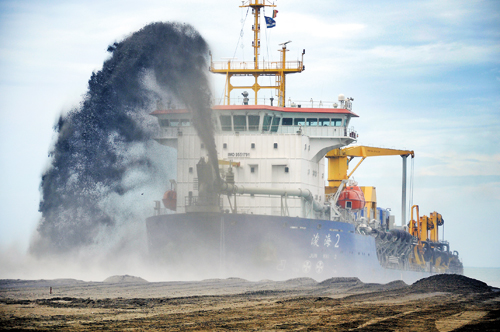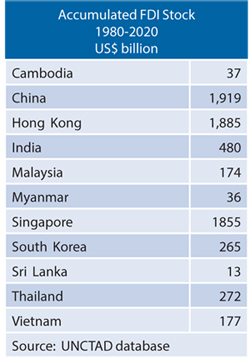Investors and lenders
View(s):
A picture taken some years ago shows work at the Colombo Port city.
The biggest problem that foreign investors face in Sri Lanka is getting access to property, particularly land, as I was told by an investor whom I met, some time ago, at a discussion forum. There is no clear path for a potential investor to acquire land, he had said. Though I believed access to land was one of the many problems for investors, he was of the view that it is the number one issue! As I recalled this conversation a few days ago, I thought of revisiting today the issue of attracting foreign direct investment (FDI) to Sri Lanka.
Although Sri Lanka inherited “capitalism” through its colonial history, the country’s land rights are still feudal. Many citizens have the “user right” to land but not the legal ownership, while about 75 per cent of land belongs to the government. If the country needs investors from abroad, they should be given land to do business; but it’s not an easy task for a foreign investor to have access to land! Of course, if it is a political decision, the investor can have a plot of land even within few weeks but if you follow the procedures, you should be ready to spend months and years meeting the bureaucrats and the lawyers. You never know how long it takes, if it has to be cleared through the commercial courts.
Although Sri Lankans buy property in foreign countries, foreigners cannot buy property in this country! Even if a foreigner finds a private property that is for sale, he cannot buy it legally without allowing for 51 per cent local ownership. Such deals, if it happens at all, encourage fraud. The question is why on earth would a foreigner resort to a fraudulent deal rather than ensuring a clean deal somewhere else?
Strange questions
Over a period of 40 years (1980-2020), Sri Lanka has accumulated FDI worth US$13 billion only. It is even lower than the FDI flows to Cambodia and Myanmar, which began opening the door to FDI only recently. The status of China, Hong Kong and Singapore are similar in terms of their accumulated FDI stocks closer to $2,000 billion. While Sri Lanka adopted market economy reforms in 1977, China did that in 1978. Some of the Asian countries which initiated policy reforms much later than Sri Lanka such as India, Thailand and Vietnam have got their FDI flows accelerated in the recent past, while they all have already reported hundreds of billions of dollars as their accumulated FDI stocks.
 By the way, we favoured foreign borrowings much more than foreign investment. Although Sri Lanka’s FDI stock was $13 billion for 40 years, the country’s foreign commercial borrowing for 12 years (2007-2019) exceeded $17 billion! Including the country’s commercial borrowings, Sri Lanka’s outstanding total foreign debt amounts to over $51 billion as at the third quarter of 2021.
By the way, we favoured foreign borrowings much more than foreign investment. Although Sri Lanka’s FDI stock was $13 billion for 40 years, the country’s foreign commercial borrowing for 12 years (2007-2019) exceeded $17 billion! Including the country’s commercial borrowings, Sri Lanka’s outstanding total foreign debt amounts to over $51 billion as at the third quarter of 2021.
It is strange that although Sri Lanka saw the importance of FDI as far back as the 1960s in attracting FDI, it continued to lag far behind many of its Asian counterparts up to now. Perhaps, for the first time a policy package for attracting FDI was announced in the Budget Speech for 1960/61; it’s quite strange that the then government asked for FDI, while carrying out its nationalisation programme acquiring even the existing foreign businesses such as oil companies, Colombo port and banking.
Then, the new government of 1965 terminated the nationalisation programme and, announced an incentive package for FDI in a White Paper in 1966. It was also a futile effort as no FDI came to Sri Lanka, even though this government had adopted policy reforms for a “partial” liberalisation and “non-traditional” export promotion. In fact, until the “open economy” was declared in 1977, there was no hope of getting FDI to Sri Lanka.
It is clear that during the period 1956-1977 the economic policies were to discourage FDI so that there is nothing unusual about not getting FDI inflows. The big question is what happened after 1977 when the open economy policy reforms were adopted, specific incentive packages for FDI were granted and the institutional mechanism was established.
New investment centre
As many other countries in the Asian region including our South Asian neighbours were still hostile to FDI, Sri Lanka became a new investment centre of Asia. But the irony is that it could attract only a handful of FDI projects, amounting to less than one billion dollars every year. Big multinationals too carried out their feasibility studies to locate their investment in Sri Lanka, but later they pulled out from the country.
Someone could bring out a valid argument to say that “it is the price that we paid for political conflicts”. We can’t deny the fact that the internal conflicts – both the separatist war in the North and the JVP insurgency in the South – had their toll in the economy. Yet, a counter argument is that, then, why didn’t FDI come in during the past 10 years when the conflicts were over? And coincidently, it was also the time when many businesses from the Western advanced countries – particularly the US, the EU and Japan, were re-locating their operations or parts of the operations to developing countries in Asia.
 What do the investors need? They need land and all other primary inputs such as skilled labour; if the country is not capable of supplying labour with required quality and quantity, it is still better to get them from other countries. They need the market so that the size of the market as well as its growth matter the most. The size of the market is determined by the population and people’s income level, while its growth is determined by GDP growth, per capita income growth and, middle-income growth. Thus, the countries which struggle to achieve economic growth or constrain the middle-class growth are not attractive to FDI.
What do the investors need? They need land and all other primary inputs such as skilled labour; if the country is not capable of supplying labour with required quality and quantity, it is still better to get them from other countries. They need the market so that the size of the market as well as its growth matter the most. The size of the market is determined by the population and people’s income level, while its growth is determined by GDP growth, per capita income growth and, middle-income growth. Thus, the countries which struggle to achieve economic growth or constrain the middle-class growth are not attractive to FDI.
Because the market size is an important determinant of FDI, smaller countries have no other choice than opening the economy to the global market. Therefore, market size is related to the degree of openness to international trade as well through policy reforms and trade facilitation. Macroeconomic stability, which can be viewed through interest rate, inflation rate, exchange rate as well as through government finance and external finance, is important for FDI because all these indicators are important for long-term business stability and profitability. There is no need to mention that state-of-the-art infrastructure plays a major role in attracting investment.
From borrowing to investment
Countries which cannot offer an investment-friendly business environment, have been attempting to cover up all weakness and bottlenecks with tax incentives. Investors expect a better business environment much more than the tax incentives, because the long-term benefit of the former is more valuable than the cost of a competitive tax system.
Unlike in the 1980s and the 1990s, it is a tough game today, because every country is trying to be better then everyone else in order to attract FDI. But the good news is that there is no shortage of FDI flows to Asian countries, which are also offering the world’s biggest market expansion.
The last question is that should we also try to benefit from the world dynamics related to today’s FDI flows? If this is the case, it is necessary to turn our policy focus from borrowing to investment. (The writer is a Professor of Economics at the University of Colombo and can be reached at sirimal@econ.cmb.ac.lk and follow on Twitter @SirimalAshoka).
Hitad.lk has you covered with quality used or brand new cars for sale that are budget friendly yet reliable! Now is the time to sell your old ride for something more attractive to today's modern automotive market demands. Browse through our selection of affordable options now on Hitad.lk before deciding on what will work best for you!


